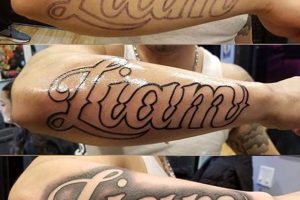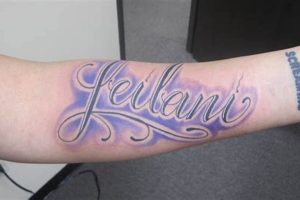Selecting appropriate typography for a name tattoo involves careful consideration of various stylistic choices. Script, gothic, traditional, and modern fonts each offer unique aesthetic qualities that can significantly impact the final result. Examples include elegant, flowing scripts for a romantic feel, bold gothic lettering for a powerful statement, or minimalist sans-serif typefaces for a contemporary look. The choice of font often reflects personal style and the desired message conveyed by the tattoo.
Permanent body art requires thoughtful design, and the selection of lettering plays a crucial role in the overall aesthetic and longevity of a name tattoo. A well-chosen typeface enhances legibility, ensuring the name remains clear and readable over time. Historically, different cultures have employed specific lettering styles for tattoos, imbuing them with symbolic meaning and artistic significance. Today, the vast array of available fonts provides individuals with unprecedented opportunities for self-expression and personalized body art.
Further exploration of this subject will cover popular font categories suitable for name tattoos, factors influencing font selection, and practical advice for collaborating with tattoo artists to achieve the desired outcome. This includes considering the placement of the tattoo, skin tone, and the overall design aesthetic to create a harmonious and visually appealing result.
Tips for Choosing Name Tattoo Fonts
Selecting an appropriate typeface for a name tattoo requires careful consideration of several factors. These tips offer guidance for navigating the process and achieving a visually appealing and meaningful result.
Tip 1: Consider Placement and Size: Intricate fonts might lose detail in smaller tattoos or on curved body parts. Simpler fonts often work better in these situations.
Tip 2: Research Font Styles: Explore various categories, such as script, gothic, traditional, and modern, to find a style that reflects personal aesthetics and the desired message.
Tip 3: Prioritize Legibility: Overly decorative or elaborate fonts can become difficult to read over time. Ensure the chosen font remains clear and legible, even as the tattoo ages.
Tip 4: Match the Font to the Name: A delicate script might suit a feminine name, while a bolder font could complement a masculine name. Consider the name’s inherent characteristics when selecting a font.
Tip 5: Consult with a Tattoo Artist: Professional tattoo artists possess expertise in font selection and can offer valuable insights based on experience and technical knowledge.
Tip 6: Test the Font: Request a stencil or digital preview of the name in the chosen font applied to the desired body part. This allows visualization of the final result and facilitates necessary adjustments.
Tip 7: Think Long-Term: Tattoo removal is a complex process. Ensure the chosen font and style remain desirable in the long term to avoid future regrets.
Careful font selection ensures a visually appealing and meaningful tattoo. By considering these tips, individuals can make informed decisions and collaborate effectively with tattoo artists to achieve desired results.
By implementing these guidelines, one can ensure a tattoo that remains aesthetically pleasing and personally meaningful for years to come.
1. Style
Style in name tattoos significantly impacts the final aesthetic and reflects individual preferences. Choosing an appropriate font style is crucial for conveying the desired message and ensuring the tattoo remains visually appealing over time. This involves considering various factors such as the name itself, placement on the body, and overall design concept.
- Script
Script fonts, characterized by flowing, interconnected letters, evoke elegance and sophistication. Calligraphic scripts offer a classic, timeless feel, while brush scripts provide a more contemporary, expressive look. Script styles are often favored for names with softer sounds or feminine connotations. Examples include names written in elegant Copperplate or free-flowing brush lettering. However, intricate scripts can lose detail in smaller tattoos, requiring careful consideration of size and placement.
- Gothic
Gothic fonts, with their bold, angular lines and dramatic serifs, project strength and power. From traditional blackletter to modern interpretations, gothic styles can create a striking visual impact. These fonts often suit names with strong sounds or masculine connotations. Examples include names rendered in Fraktur or Old English text. However, gothic fonts can be less legible than simpler styles, particularly in smaller sizes.
- Traditional
Traditional tattoo fonts, often associated with American traditional or Japanese tattooing, offer a timeless appeal. Bold outlines, simple shapes, and limited ornamentation characterize these styles. Traditional fonts are highly versatile, working well with a wide range of names and placements. Examples include bold Sailor Jerry-inspired lettering or classic Americana designs. These fonts prioritize clarity and legibility, ensuring the name remains recognizable over time.
- Modern/Minimalist
Modern and minimalist fonts emphasize clean lines, geometric shapes, and simplicity. Sans-serif fonts, in particular, offer a contemporary aesthetic. These styles are suitable for individuals seeking a subtle, understated tattoo. Examples include names written in Helvetica or Futura. Minimalist fonts are highly legible and work well in various sizes and placements.
Ultimately, the chosen style should complement the individual’s personality and the specific name being tattooed. Harmonizing the font style with other design elements, such as accompanying imagery or the tattoo’s placement, contributes to a cohesive and visually compelling final product. Careful consideration of these factors ensures a tattoo that remains personally meaningful and aesthetically pleasing for years to come.
2. Legibility
Legibility is paramount when choosing a font for a name tattoo. A tattoo’s permanence necessitates careful consideration of how the chosen typeface will age. Intricate details and thin lines, characteristic of some decorative fonts, can blur or spread over time, potentially rendering the name illegible. This degradation is influenced by factors such as skin type, sun exposure, and the tattoo artist’s skill. Therefore, prioritizing legibility ensures the name remains recognizable and aesthetically pleasing for years to come. For instance, a highly stylized script font, while initially attractive, might become difficult to decipher after a decade, whereas a simpler, bolder font will likely retain its clarity.
The practical implications of legibility extend beyond mere readability. A name tattoo often carries significant personal meaning, representing a loved one, a personal belief, or a milestone. Compromised legibility diminishes this intended message, transforming a meaningful tribute into an indecipherable mark. Consider the difference between a clearly rendered name in a classic typeface, easily recognized and appreciated by others, and a stylized script that requires close inspection or explanation. The former maintains its communicative power, while the latter loses its impact due to poor legibility.
Balancing aesthetics with legibility requires careful font selection. While decorative elements can enhance a tattoo’s visual appeal, they should not compromise clarity. Consulting with an experienced tattoo artist is crucial. Artists can advise on suitable fonts, considering factors like the name’s length, placement on the body, and the individual’s skin type. They can also offer modifications to existing fonts, striking a balance between desired stylistic elements and long-term legibility. Ultimately, a legible name tattoo ensures the intended message remains clear, preserving the tattoo’s aesthetic and personal significance over time.
3. Size
Size plays a crucial role in the effectiveness of name tattoos. The chosen font must remain legible and aesthetically pleasing, regardless of scale. This involves considering the interplay between font style, name length, and the desired placement on the body. Appropriate sizing ensures the tattoo remains proportionate and visually balanced within its designated area.
- Small Tattoos:
Small name tattoos require careful font selection. Intricate details or thin lines can become blurred or lost as the tattoo ages. Simple, bold fonts with clean lines are often more suitable for smaller scales, ensuring legibility and visual impact. Placement on the body also influences font choice; a small tattoo on the wrist might benefit from a sans-serif font, while a similar-sized tattoo on the back could accommodate a slightly more decorative style.
- Large Tattoos:
Larger tattoos offer more flexibility in font choice. Intricate scripts, decorative elements, and greater stylistic flourishes can be incorporated without compromising legibility. The increased surface area allows for more complex designs and detailed lettering. However, even at larger scales, the chosen font should complement the name and the overall aesthetic. A large, elaborate script might overwhelm a short, simple name, while a bold, blocky font might clash with a delicate, flowing design.
- Proportion and Balance:
The size of the tattoo should be proportionate to both the name and the body part. A long name crammed into a small space can appear cluttered and illegible. Conversely, a short name stretched across a large area might appear unbalanced and visually weak. Maintaining appropriate proportions ensures the tattoo complements the body’s contours and remains aesthetically pleasing.
- Practical Considerations:
Practical considerations, such as future changes to the body, should also influence size decisions. Areas prone to significant weight fluctuations or skin stretching might not be suitable for large, intricate tattoos. Similarly, tattoos located near joints or areas of high movement might require simpler, more robust fonts to withstand distortion. Considering these factors ensures the tattoo retains its visual integrity over time.
Ultimately, size is an integral aspect of name tattoo design, impacting legibility, aesthetics, and longevity. Careful consideration of size, in conjunction with font style, name length, and placement, ensures the tattoo remains a visually compelling and personally meaningful piece of body art.
4. Placement
Placement significantly influences the aesthetic and practical aspects of name tattoos. The chosen location on the body interacts with the font style, size, and overall design, impacting legibility, visual balance, and the tattoo’s symbolic meaning. Careful consideration of placement ensures the tattoo harmonizes with the body’s contours and effectively conveys the intended message.
- Wrist
The wrist offers a prominent yet discreet location for name tattoos. Smaller, simpler fonts are often preferred due to the limited surface area and the curvature of the wrist. Script fonts or minimalist typefaces can create an elegant and subtle effect. However, tattoos on the wrist are more exposed to the elements and may experience faster fading.
- Inner Arm
The inner arm provides a relatively flat and less exposed surface, accommodating larger designs and more intricate font styles. Longer names or those incorporating additional design elements can be effectively placed here. The inner arm also offers greater discretion compared to more visible locations.
- Back/Chest
The back and chest offer expansive canvases for larger, more elaborate name tattoos. These placements allow for greater flexibility in font choice and size, accommodating intricate scripts, bold gothic styles, or larger traditional lettering. However, tattoos in these areas require careful planning to ensure proper proportions and visual balance.
- Ribcage/Side
The ribcage and side of the body offer a more curved surface, presenting unique design considerations. Flowing script fonts or fonts with a natural curve can complement the body’s contours. However, the sensitivity of these areas requires careful consideration of pain tolerance during the tattooing process.
Effective placement enhances the visual impact and personal significance of name tattoos. The chosen location should complement the font style, size, and overall design, creating a harmonious and balanced composition. Considering the practical aspects of visibility, sun exposure, and potential changes to the body ensures the tattoo remains aesthetically pleasing and meaningful over time.
5. Personalization
Personalization is integral to name tattoos, transforming a simple inscription into a unique expression of identity. Font selection plays a crucial role in this process, allowing individuals to imbue their chosen name with specific stylistic nuances and symbolic meaning. This involves considering various factors, including the name’s cultural or historical context, the individual’s personality, and the desired aesthetic.
- Cultural/Historical Context
Names often carry cultural or historical significance. Choosing a font that reflects this heritage can add depth and meaning to the tattoo. For example, a name with Gaelic origins might be rendered in a Celtic-inspired font, or a name with Japanese roots could utilize a traditional Japanese lettering style. This personalized approach imbues the tattoo with a deeper connection to ancestry and cultural identity.
- Individuality
Font selection can reflect an individual’s personality and style. A bold, gothic font might suit someone with a strong, rebellious spirit, while a delicate, flowing script might be chosen by someone with a more romantic sensibility. This allows the tattoo to serve as a visual representation of the individual’s character and self-expression.
- Aesthetic Preferences
Personal aesthetics play a significant role in font selection. Some individuals might prefer the clean lines of a minimalist sans-serif font, while others might gravitate towards the ornate details of a decorative script. The chosen font should align with the individual’s overall aesthetic preferences, ensuring the tattoo remains visually appealing and personally satisfying.
- Meaning and Symbolism
Incorporating symbolic elements into the font design can further personalize the tattoo. Adding flourishes, embellishments, or incorporating meaningful imagery alongside the name can enhance its symbolic value. For example, intertwining a name with floral motifs could symbolize growth and beauty, or incorporating geometric patterns might represent strength and stability. This layered approach adds depth and complexity to the tattoo’s meaning.
By carefully considering these elements of personalization, individuals can create name tattoos that transcend mere inscriptions, becoming powerful expressions of identity, heritage, and personal meaning. The chosen font, imbued with individual significance, transforms the tattoo into a unique and enduring piece of personal art.
6. Meaning
Name tattoos often carry profound personal significance, extending beyond mere aesthetics. The chosen font, style, and accompanying elements can amplify this meaning, transforming a simple inscription into a powerful symbol of identity, heritage, or personal values. Understanding the interplay between typography and meaning allows individuals to create tattoos that resonate deeply and endure over time.
- Memorialization
Name tattoos can serve as lasting tributes to loved ones, commemorating their presence and impact. The chosen font can reflect the individual’s personality or shared experiences. A flowing script might evoke a sense of gentle remembrance, while a bolder font could symbolize strength and resilience. For example, a tattoo commemorating a parent might incorporate their name in a font reminiscent of their handwriting, adding a deeply personal touch to the memorial.
- Cultural Heritage
Names often carry cultural or historical significance. Utilizing fonts that reflect this heritage can strengthen the connection to ancestry and identity. A name with Gaelic origins might be rendered in a Celtic-inspired font, or a name with Japanese roots could incorporate traditional Japanese calligraphy. This approach infuses the tattoo with cultural meaning, transforming it into a symbol of heritage and belonging.
- Personal Values
Name tattoos can represent deeply held personal values or beliefs. The chosen font and style can reflect these values, transforming the tattoo into a visual representation of one’s guiding principles. A name representing strength might be rendered in a bold, angular font, while a name symbolizing peace could utilize a flowing, calming script. This symbolic approach adds layers of meaning to the tattoo, reflecting the individual’s core beliefs.
- Life Milestones
Name tattoos can commemorate significant life milestones, marking pivotal moments or transitions. The chosen font can reflect the nature of the milestone, adding symbolic weight to the inscription. A name representing a child’s birth might be rendered in a playful, whimsical font, while a name marking a significant achievement could utilize a more formal, classic style. This approach imbues the tattoo with personal significance, creating a lasting reminder of the transformative event.
By carefully considering the meaning behind a name tattoo and selecting a font that amplifies this significance, individuals can create powerful and enduring symbols of personal identity, heritage, and values. The chosen typography becomes more than just an aesthetic choice; it becomes a vehicle for expressing profound meaning and creating a lasting connection to the name’s significance.
7. Artist Consultation
Effective collaboration with a skilled tattoo artist is essential when choosing a font for a name tattoo. Artists possess technical expertise and aesthetic sensibilities that significantly contribute to successful outcomes. They can assess factors such as skin tone, body contours, and the name’s length to recommend appropriate font styles and sizes. This consultation ensures the chosen font complements the individual’s characteristics and desired aesthetic, resulting in a harmonious and technically sound tattoo. For example, an artist might advise against an intricate script for a small wrist tattoo due to potential legibility issues, suggesting a bolder, simpler font instead. Conversely, they could guide the selection of an elaborate script for a larger back piece, maximizing its visual impact.
Beyond technical considerations, artists offer valuable insights into design elements that enhance the tattoo’s overall aesthetic and meaning. They can suggest personalized modifications to standard fonts, incorporating unique flourishes or stylistic elements that reflect individual preferences. They can also advise on incorporating complementary imagery or design motifs that enhance the name’s symbolic significance. For instance, an artist might suggest intertwining a name with floral elements to symbolize growth and remembrance or incorporating geometric patterns to represent strength and stability. This collaborative approach ensures the final design resonates with the individual’s vision and desired message. Furthermore, experienced artists can anticipate potential challenges related to tattoo aging and offer solutions to maintain long-term legibility and aesthetic appeal. This forward-thinking approach contributes to a tattoo that remains visually compelling and personally meaningful for years to come. For example, an artist might recommend slightly thicker lines for a script font to prevent blurring over time or suggest a specific ink color that complements the individual’s skin tone and ages gracefully.
Ultimately, artist consultation is an invaluable component of the font selection process for name tattoos. This collaborative approach combines technical expertise with artistic vision, resulting in a tattoo that is both aesthetically pleasing and personally meaningful. By leveraging an artist’s knowledge and experience, individuals can make informed decisions, ensuring the chosen font and design elements contribute to a successful and enduring piece of body art.
Frequently Asked Questions about Name Tattoo Fonts
This section addresses common queries regarding font selection for name tattoos, offering practical guidance for individuals considering this form of personal expression.
Question 1: How does one choose a font that remains legible over time?
Prioritizing legibility requires selecting fonts with clear, distinct lines, avoiding overly intricate or thin-lined styles that might blur with age. Consulting a tattoo artist is crucial for assessing how specific fonts will age on individual skin types.
Question 2: What are suitable font choices for small name tattoos?
Simpler, bolder fonts often work best for smaller tattoos, ensuring legibility despite limited space. Minimalist styles and clean-lined scripts are generally recommended for smaller placements like the wrist or ankle.
Question 3: Can cultural heritage be reflected through font selection?
Specific fonts can evoke cultural or historical associations. Celtic-inspired fonts might suit names with Gaelic origins, while traditional Japanese lettering can complement names with Japanese roots. Researching fonts associated with specific cultures can add depth and meaning to the tattoo.
Question 4: How does placement on the body influence font choice?
Placement interacts with font style and size. Curved body parts, like the wrist or ribcage, might benefit from flowing scripts that complement their contours. Larger, flatter areas, like the back or chest, offer more flexibility for intricate designs and larger fonts.
Question 5: What is the importance of consulting with a tattoo artist regarding font selection?
Tattoo artists possess technical expertise in font selection, considering factors like skin type, tattoo placement, and long-term legibility. They can offer personalized recommendations and suggest modifications to standard fonts, ensuring the final result aligns with individual preferences and aesthetic goals.
Question 6: How can one ensure a name tattoo remains personally meaningful over time?
Selecting a font that resonates with personal style, the name’s meaning, and cultural context contributes to long-term satisfaction. Careful consideration of these factors, alongside professional consultation with a tattoo artist, ensures the tattoo remains a cherished piece of personal expression.
Careful consideration of these frequently asked questions empowers individuals to make informed decisions regarding font selection, ensuring their name tattoos remain aesthetically pleasing, legible, and personally meaningful for years to come.
For further exploration, the following section will delve into specific examples of popular fonts suitable for name tattoos, providing visual inspiration and detailed explanations of their characteristics.
Conclusion
Careful font selection is paramount for name tattoos, impacting legibility, aesthetics, and personal significance. This exploration has highlighted the importance of considering factors such as style, size, placement, and the name’s inherent meaning when choosing a font. Collaboration with experienced tattoo artists is crucial for navigating the complexities of font selection and ensuring a technically sound and aesthetically pleasing result. Prioritizing legibility ensures the name remains recognizable over time, while thoughtful personalization imbues the tattoo with individual meaning and cultural relevance. From classic scripts to bold gothic styles, the diverse range of available fonts offers ample opportunities for self-expression and personalized body art.
Ultimately, a well-chosen font elevates a name tattoo beyond mere inscription, transforming it into a powerful symbol of identity, heritage, or personal values. This permanent form of expression requires careful consideration and informed decision-making, ensuring the chosen typography resonates with individual preferences and stands the test of time. Thorough research, artist consultation, and thoughtful reflection empower individuals to create name tattoos that remain cherished and meaningful throughout their lives.







